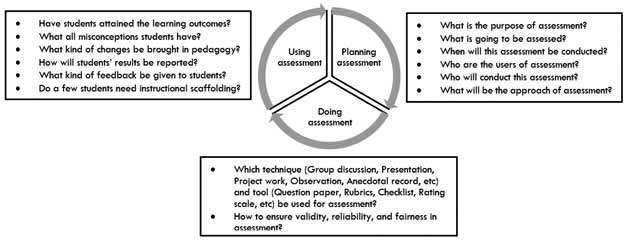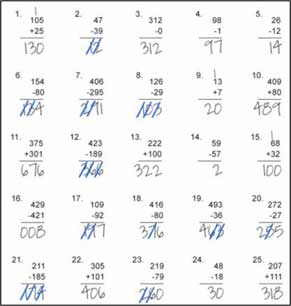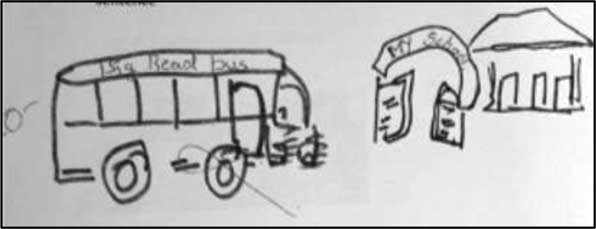Shilpi Banerjee
Teaching plans are incomplete unless they accommodate assessment plans as well. It is crucial that teaching plan and assessment plan go hand in hand to ensure effective teaching and learning. As stated in the National Education Policy, 2020, “The underlying principle for assessment at all levels of education will be for learning, it should help the teacher and student, and the entire schooling system, continuously revise teaching-learning processes to optimize learning and development for all students.” Therefore, it becomes very important to understand the underlying principles of using assessment for learning.
Stages in conducting assessments
For a teacher to be able to use assessment as a teaching tool, it must be effective and conducted using appropriate tools and techniques. Figure 1 shows the three important stages – planning, doing, using – in designing assessments and the key questions to be answered in each stage.
Formative uses of assessment help teachers monitor student learning that is in progress, provide them with specific feedback and help them make appropriate instructional changes. Summative assessment results help a teacher evaluate student learning after teaching one or more units of a course. This article focuses on the third stage of designing assessments and includes some core principles that guide ‘using assessment’ for meaningful teaching and learning.

Key principles of using assessment
- Activating prior knowledge
Learning outcomes indicate what a student has learnt or will be able to do after engaging with a topic/ chapter/subject. In a way, learning outcomes define the end. In order to help students attain the learning outcomes, the teacher must pose optimal guiding questions to activate prior knowledge. Activating prior knowledge is important because it helps link what students already know (prior knowledge) to what they will be learning (learning outcome). Students combine prior knowledge with their learning experiences to construct new knowledge.
Diagnostic assessment should be conducted before beginning a new topic by asking questions such as “What do you already know about _? Have any of you ever experienced this _?, and What have you read about before _?” These are open questions and do not have one right answer. Every student should be encouraged to speak while the teacher listens patiently to understand their existing knowledge and tune her pedagogy to the desired learning outcome accordingly.
2. Understanding knowledge construction
Students construct knowledge by interpreting new experiences and knowledge in the light of knowledge they already have. Any flaw in knowledge construction can be caught using a variety of assessment techniques such as discussion, observation and questioning. The Socrates method of questioning (see example below) is a powerful tool to encourage students to think through their own answer and help in the construction of knowledge from their own perspective.
Learning outcome – Class II mathematics: To be able to identify 2D shapes (rectangle, square, triangle, circle) by their names.
| Question | Student’s response |
Which shapes are rectangles? | Shapes 1 and 2 are rectangles. Shape 3 is a rectangle, it is just slanted up. Shapes 4, 5 and 6 are not rectangles. |
| Socrates question types | Socrates question types – Example |
| Questions that clarify | Why do you think shapes 1, 2 and 3 are rectangles? |
| Questions that challenge assumptions | Both shapes 3 and 6 are slanted. Why then is shape 3 a rectangle and shape 6 not? |
| Questions that examine evidence or reasons | Why are shapes 4, 5 and 6 not rectangles? |
| Questions about viewpoints and perspectives | How is shape 5 different from shapes 4 and 6? |
| Questions that explore implications and consequences | If any two parallel sides of shapes 1 and 2 were slanted, would they still be rectangles? |
| Questions about the question | If shapes 1, 2, 3, 4 and 6 are rectangles, then what can you comment on the relationship between square, rectangle and parallelogram? |
3. Analyzing students’ responses
Formative assessment is embedded in teaching-learning that takes place in the classroom and has four essential steps- clarify and facilitate intended learning outcomes in the students, elicit evidence to understand how far students have attained the learning outcomes, interpret those evidences to understand what misconceptions/learning gaps the student has and finally take corrective actions based on the evidence to decide the future course of action.
There are multiple learnings that can be derived from a student’s response to a question, testing his/her understanding of a certain concept. These learnings should be fed back into the teaching-learning loop to address the gap in the student’s understanding and to help them reflect on their learning and thereby empower them to self-assess.
Learning outcome – Class II mathematics: To be able to solve problems based on addition of three-digit numbers.
| Student’s response to 3 digit addition and subtration problems | Analyzing student’s response |
 | Student has mastered the following- · Performs basic number addition facts: The student knows basic facts about addition. · Understands place value: The student records the answer so that the numbers are in the appropriate column. · Understands regrouping: The student regroups and applies regrouping strategies. · Performs correct operation: Student recognizes and uses the correct operation. Student has learning gaps in following areas- · Subtracts the lesser number from the greater number: Regardless of placement, the student always subtracts the lesser from the greater number. · Does not regroup with 0: When a problem contains one or more 0s in the top number (minuend), the student is unsure what to do. |
4. Providing constructive feedback
Good teachers know how to use the assessment process to energize, inspire and motivate students by providing them continuous feedback. Feedback is crucial to link assessment and the action following that assessment. This ongoing cycle of assessment and feedback can help students as they move along the learning continuum. This will help them take charge of their own learning, self-assess their learning against the desired outcome and enable them to adjust and adapt their learning. Teachers should provide individualized descriptive feedback on students’ responses instead of giving evaluative feedback in the form of marks or grades. Feedback should indicate student’s current attainment of learning outcome and provide clear directions for improvement.
Learning outcome – Class II English: To be able to compose and write simple, short sentences with space between words.
| Question and student’s response | Comment |
Draw a picture in the given box. Describe the picture in one sentence. | Student has drawn a school building, school main gate and school bus. Student has written ‘Big read bus’ over the bus and ‘My school’ over the gate. Teacher has marked this response as wrong and given zero marks. Student has tried to describe her school pictorially and has used an adjective to describe the school bus. However, the student lacks understanding of sentence structure. The teacher’s qualitative feedback will help the student understand the mistake. A cross mark alone will not help the student understand what the problem is. |
References
- Lefa, B. (2014). The Piaget theory of cognitive development: an educational implication. Educational psychology, 1(9), 1-8.
- Padesky, C. A. (1993, September). Socratic questioning: Changing minds or guiding discovery. In A keynote address delivered at the European Congress of Behavioural and Cognitive Therapies, London (Vol. 24).
- Black, P., & Wiliam, D. (2009). Developing the theory of formative assessment. Educational Assessment, Evaluation and Accountability, 21(1), 5.
- Earl, L. M. (2012). Assessment as learning: Using classroom assessment to maximize student learning. Corwin Press.
The author works as a faculty member at Azim Premji University. She has a background in engineering with a specialization in educational assessment. Her research interests include development of feasible quality assessment prototypes for classroom purposes, assessment design and statistical evaluation of large-scale assessment data. She also teaches educational assessment to MA education students. She can be reached at shilpi.banerjee@azimpremjifoundation.org.
